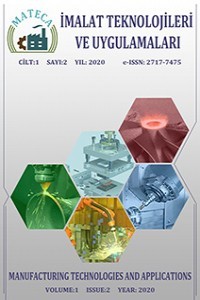17-4PH Paslanmaz Çeliğin Kuru Ortamda Frezelenmesinde Kesme Parametrelerinin İşlenebilirlik Kriterlerine Etkilerinin Araştırılması
17-4 PH çelik, iyi korozyon direnci ve yüksek mekanik özelliklerin olağanüstü bir uyumuna sahip olup martensitik çökeltme ile sertleşen bir paslanmaz çeliktir. Aynı zamanda, işlenebilirliği zor olan malzemelerden olan bu çeliğin özellikle frezelenmesi üzerine yok denecek kadar az araştırma yapıldığı literatürden belirlenmiştir. Bu nedenle, söz konusu çeliğin kaplamalı karbür uçlar ile çevreye duyarlı bir kesme rejimi olan kuru kesme ortamında frezelenmesi üzerine deneysel bir araştırmaya odaklanılmıştır. Zıt yönlü frezeleme tekniği ile yapılan deneylerde, işleme sırasında ortaya çıkan bileşke kesme kuvveti (Fr), yüzey pürüzlülüğü (Ra) ve toplam kesme gücü veya enerji tüketiminin PcT kesme parametrelerine göre değişimleri araştırılmıştır. Üç farklı kesme hızı (V), ilerleme oranı (f) ve kesme derinliği (ap) seçilerek L9 deneysel tasarıma göre deneyler yapılmıştır. Kistler marka dinamometre ve ekipmanları ile ölçülen kesme kuvveti bileşenleri yardımıyla Fr değerleri hesaplanmıştır. Fr’nin büyüklüğü daha çok kesme derinliği (%64.92) ve ardından ilerleme miktarına (%30.26) bağlı olup, kesme hızının artmasıyla kuvvetlerin nispeten azaldığı belirlenmiştir. Ra ise esasen ilerleme hızından (%65.52) etkilenirken, kesme hızının küçümsenmeyecek düzeyde olumlu bir etkiye (%33.78) sahip olduğu görülmüştür. PcT sonuçlarına göre, talaş kesiti değişmeksizin, yüksek kesme hızında fener mili devir sayısına bağlı enerji tüketimi artmasına rağmen, artan kesme sıcaklığı yüzünden malzeme dayanımındaki azalma toplam enerji tüketiminin azalmasını sağlamıştır. Bununla birlikte, en düşük PcT değeri kesme parametrelerinin en küçük seviyelerinde elde edilmiştir. Tüm sonuçlar ışığında, endüstriyel uygulamalarda mutlaka optimize edilmiş kesme parametrelerinin kullanılması sürdürülebilirliğe katkı açısından önerilmektedir.
Anahtar Kelimeler:
PH 17-4, Frezeleme, Kesme Kuvveti, Enerji Tüketimi, Yüzey Pürüzlülüğü
Analyzing the Effects of Cutting Parameters on Machinability Criteria in Milling of 17-4PH Stainless Steel under Dry Environment
17-4 PH steel is a martensitic precipitation hardening stainless steel with an excellent convenience of good corrosion resistance and high mechanical properties. At the same time, it has been determined from the literature that very little research has been done on the milling of this steel, which is one of the materials that are difficult to process. Therefore, an experimental research was focused on the milling of the steel with coated carbide inserts in a dry cutting environment, which is an eco-friendly cutting regime. In the experiments performed with the up milling technique, the changes in the resultant cutting force (Fr), surface roughness (Ra) and total cutting power or energy consumption (PcT) during machining were investigated. Experiments were performed according to the L9 experimental design by choosing three different cutting speeds (V), feed rate (f) and cutting depth (ap). Fr values were calculated with the help of cutting force components measured with Kistler brand dynamometer and equipment. The magnitude of Fr mostly depends on the cutting depth (64.92%) and then the feed rate (30.26%), and it was determined that the forces relatively decreased with the increase in cutting speed. While Ra was mainly affected by the feed rate (65.52%), it was observed that the cutting speed had a substantial positive effect (33.78%). According to the PcT results, although the energy consumption owing to the spindle speed increased at high cutting speed without changing the chip cross-section, the decrease in material strength as a result of the increased cutting temperature led to a decrease in the total energy consumption. However, the lowest value was obtained at the smallest levels of the machining parameters. In the light of all the results, it is recommended to use optimized cutting parameters in industrial applications in terms of contributing to sustainability.
Keywords:
17-4 PH, Milling, Cutting force, Energy consumption, Surface roughness,
___
- M. Günay, Modeling and multiple optimization in face milling of hardfacing welding applied steel: Force, roughness, power, Proceedings of the Institution of Mechanical Engineers, Part C: Journal of Mechanical Engineering Science, 236(12): 2022.
- Yayın Aralığı: Yılda 3 Sayı
- Başlangıç: 2020
- Yayıncı: Mustafa GÜNAY
Sayıdaki Diğer Makaleler
Levent UĞUR, Hakan KAZAN, Barış ÖZLÜ
Hakan YURTKURAN, Mustafa GÜNAY
Pnömatik Tahrikli Çekme Yayı Yorulma Makinesi Tasarım ve İmalatı
Fatih ÖZEN, Muhammet Kaan ÇOBANOĞLU, Ahmet İLHAN, Salim ASLANLAR, Hakkı Taner SEZAN
Paslanmaz Çeliklerin Farklı Akımlarda MİG Kaynak Yöntemiyle Birleştirilmesinin İncelenmesi
